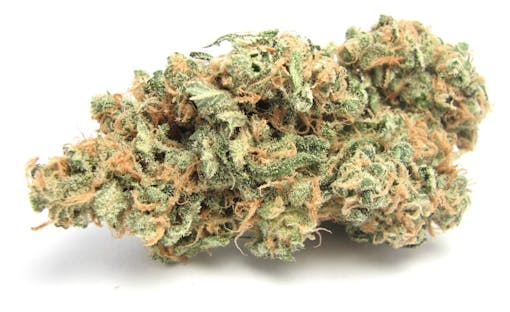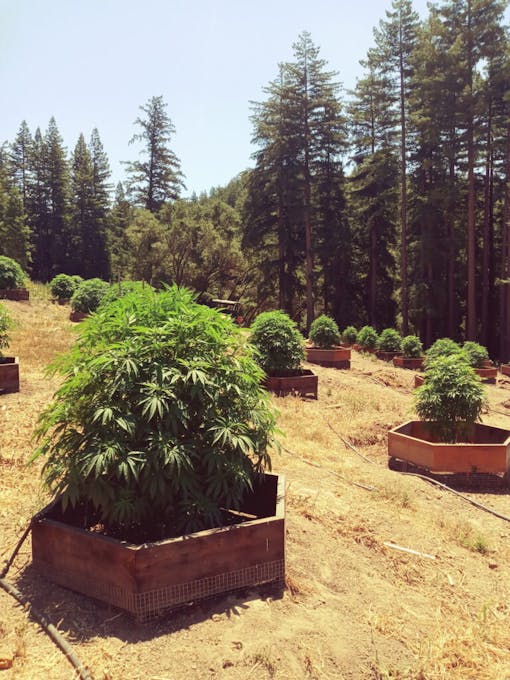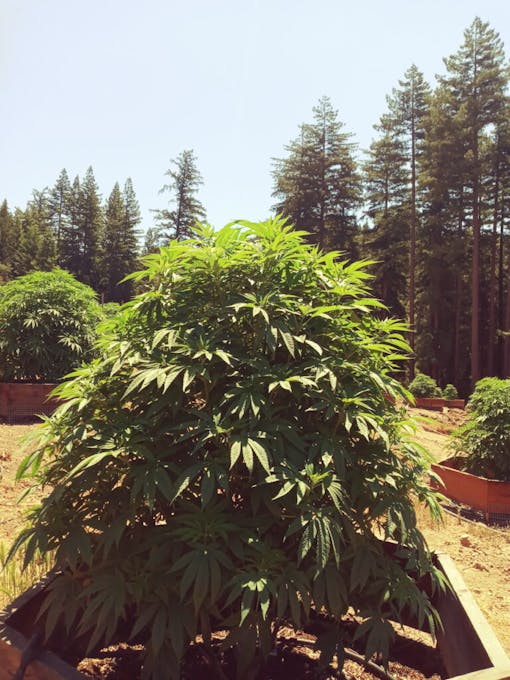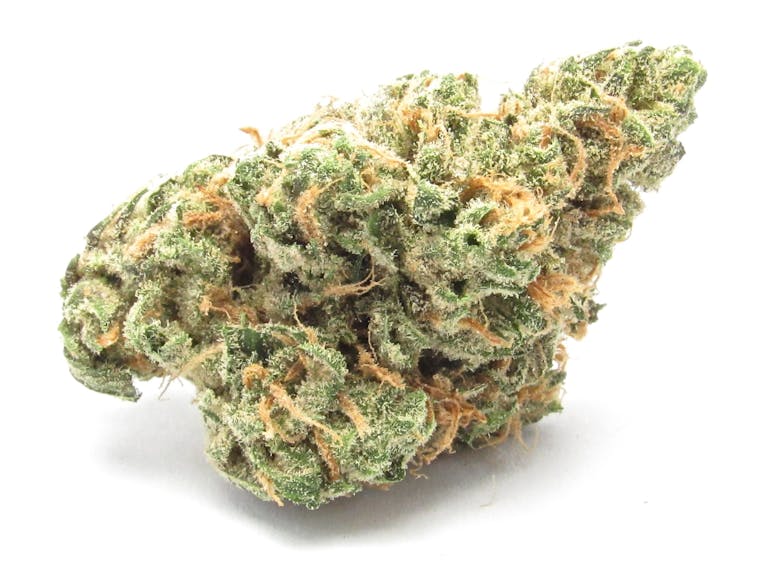Marine fog casts a gray haze and fills the air with palpable moisture on the coastal bluff overlooking the vast blue expanse of the Pacific Ocean.
The puffs of smoke floating off my joint seem to meld in perfectly with the hazy setting as I belly-up to the railing on a cliff-side fence to secure a view of surfers catching the early morning waves at The Hook, a famed surf break in Santa Cruz’s Pleasure Point neighborhood.
It’s one day post-Memorial Day 2021, so “hot vax Summer” has officially begun, and I’m smoking Blue Dream in the city that launched the globally renowned cultivar in 2003. Few places on Earth have a cannabis culture as deep and influential.
Sure, the early 21st century’s great Blue Dream flood has since receded. Today the strain is considered ubiquitous, well-liked, and basic. And yet, no one has ever figured out who made the hybrid. Until now I hope.
I’ve arrived pre-equipped with an affordable $50 quarter ounce from Santa Barbara-based cultivator Pacific Stone. With a perfumy funk in its aroma, a hit of Blue Dream evokes tastes of earth and sweet berries that’s instantly familiar. Adequately dense, but not rock hard, the nugs are pale green with orange hairs and, while its appearance does showcase a bit of frostiness from the trichomes, it’s not incredibly sticky to the touch.
Producing consistent THC percentages around 18 percent, this mellow strain is energizing, but not like a stress-inducing sativa. When I smoke it alongside the beach in Santa Cruz, it feels like meeting up with an old college friend. Familiar and easygoing, the effects fall right back into place.
Blue Dream has always been a strain that’s rewarded growers as much as smokers. It’s easy to grow with high yields, and thus, notorious for being overgrown and available everywhere. Familiarity breeds contempt, and by the mid-teens connoisseurs sought newer flavors.
Still, this strain and its ability to remain viable in a market now dominated by proprietary pot show just how much power it has. It’s a power fueled by the botanists, outlaws, and activists who gave the small, liberal surf city of Santa Cruz, California, an outsize role in shaping the history of cannabis.
Every nug of the stuff contains this story—of Santa Cruz, and of the last big genetic wave to sweep through medical marijuana; a wave that peaked and crashed, and yet still inundates the market to this day.
A stone-cold fan favorite
In an adult-use consumer marketplace that has become dominated by brands, rather than strains, Blue Dream continues to be a staple for many larger cannabis operations, particularly those focused on value offerings.
It was one of the first strains to be extracted by the major California brand AbsoluteXtracts, said James Rowan, director of major brands. They’ll always sell it.
Shop highly rated dispensaries near you
Showing you dispensaries near“It has been a fan-favorite from the beginning,” he said. “It tastes amazing, with hints of its Blueberry lineage showing through, and leads to a gentle, cerebrally stimulating high that is excellent for daytime functionality and uplifting relief.”
A hybrid blend of a stretchy, late-flowering sativa Haze and an indica-leaning Blueberry, Blue Dream came about in the early 2000s and remains one of the most recognizable and available types of marijuana.

Nearly a decade after it arrived, Juicy J secured its legacy with the Blue Dream & Lean mixtape released in 2011 — “You say no to drugs, Juicy J can’t.”
The strain was the number #1 seller in both Washington and Colorado in 2015 and was also the only type of cannabis that crossed over as a top seller in both places.
Even in 2021, Blue Dream continues to join in the line-up of the top 10 strains viewed in Leafly’s extensive database and has the most reviews by far at over 13,000. And it hasn’t left popular culture either; both Weezer and Prometheus Brown released songs called Blue Dream this year.
This strain’s staying power has as much to do with its hearty and consistent genetics as the region that nurtured it. In California’s medical marijuana era, Santa Cruz and its rugged mountains became a key ally for the plant, and a wellspring of weed that humanity would tap for decades to come.
Time travelin’ to The Cosmic Boogie

Flanked by redwood forests and the ocean, Santa Cruz is situated on the northern edge of Monterey Bay. It’s been a bastion of liberal politics since the arrival of hippie and surf culture in the 1970s. Its combination of a warm-summer Mediterranean climate and an oceanfront amusement park makes it an ideal summertime destination.
I’m driving on a winding road high up in the Santa Cruz Mountains and cherishing the sights of coastal redwoods, oak, and madrone as I pull further away from my home in urban Oakland where I holed up for almost all of 2020.
My search for the fountain of Blue Dream has brought me to a unique cannabis grow located at a former Boy Scout camp in Boulder Creek.
It’s breathtakingly beautiful when the sun-dappled shade of the tree-lined road gives way to a bright, light-filled meadow. Healthy cannabis plants dot the hillside—the soil is enclosed in redwood hexagons to keep the gophers out.

I walk up the hill a bit to meet my host Jeff Nordahl of Jade Nectar. Nordahl curates an extremely unique collection of pot in the garden, and introduces me to a relatively ancient Santa Cruz grower, Yoda.
This farm is unique—for its collection of rare, pure pot types, and for its existence at all. Countless medical and illicit farms used to hide in these rugged, tall, coastal mountains. Since 2016, legalization’s licensed grows have moved down the hills and onto low-lying commercial farmland, which isn’t great for the weed. The lowland areas get pretty foggy, which causes mold. At this grow, we’re in the San Lorenzo Valley behind Empire Grade, which blocks the moisture of the marine layer and keeps the area surprisingly dry and warm.
As we walk with Yoda into the Boy Scout’s mess hall to find some shade from the intense sun, Nordahl points out the hillside dotted with burned-out trees from the wildfires which swept through the mountains in 2020. The fires are a massive challenge of growing in these mountains, as are heatwaves coming sooner every year, which bring on plagues of pests like thrips.

Nordahl has been growing cannabis in Santa Cruz since 2011, but Yoda has been growing in the area all the way back to 1974 and wants to show me some precious vintage mementos.
It feels magical when he unrolls a 46-year-old scroll—a branded marijuana product page for the strain Haze—hand-signed by one of the strain’s original progenitors, a person known only as RL, from the 1970s.

With text that begins “The Cosmic Boogie – 1976” the poster contains artwork for the Original Haze and instructions for growing cannabis.
Yoda explains that labeling your weed was a certified trend in the Santa Cruz cannabis scene way back in the 1970s. He branded his weed and created labels that he’d put on his baggies. Yoda is really proud of the cannabis he grows. In the garden in the meadow below grows bushes descended from 1970’s African landraces. The seeds had come from seeded bud wrapped in banana leaves.
So who made Blue Dream?
Despite its prolific impact on cannabis, no one has stepped up claiming to be the creator of the billion-dollar strain. Unlike the classic cannabis of the hippie days, it didn’t emerge from a seed bank in Amsterdam or an enthusiast’s California home grow. No one knows exactly where it came from. It has no breeder, no branding, and no labels.
The story is that it’s a clone-only offering originating from Santa Cruz within the collectives of the medical marijuana era. It shows up around 2003.
Blue Dream is generally accepted as a hybrid cross of Haze with a Blueberry from the famed breeder DJ Short. Alternate lineage tales place it as a Blueberry and OG Kush cross from Mystic Seeds as well as a cross of Blueberry and Super Silver Haze from Humboldt Seed Organization.
When I ask Yoda why he thinks no one wanted to claim Blue Dream, he says it’s because it’s just another strain with no true history behind it.
When I ask Yoda why he thinks no one wanted to claim Blue Dream, he says it’s because it’s just another strain with no true history behind it. He grew it and didn’t like it, he says.
Nordahl explains that by 2011 the Santa Cruz market was completely over-saturated in hazy blueberry, but admits it does have some merit.
“It’s almost like a landrace for Santa Cruz,'” he says. “It was acclimated and it grows really well for this environment. It finishes right on time, right on point.”
Leading cannabis horticulture authority Ed Rosenthal confirms Blue Dream as a cross of Haze and DJ Short’s Blueberry. The strain makes an appearance in his upcoming 2021 book release, the Cannabis Grower’s Handbook, as the singular example of a hybrid strain.
![]()
Source Blue Dream ![]()
Hondeydew Blue Dream
Whoever made it showed skill, smarts, and imagination.
“Those were two very different varieties,” he says of Blue Dream’s parentage when asked why he chose the strain to depict hybrids. “Of course, the Blueberry itself was refined as a hybrid so by the time that cross happened [Blue Dream] was pretty stable.”
Its genes have power. Rosenthal fondly remembers a particular Haze cross, an NL #5 x Haze, as one of the strongest strains he’s ever experienced regarding its effects, but says that specific strain is challenging to grow in most environments.
“Blue Dream is considerably easier,” he says. “It’s an odd combination that gave it a more than moderate yield in less time.”
S.C. weed makes waves
Few places on Earth can claim to have generated as many global cannabis currents as Santa Cruz.
In some tellings, the provenance of one of Blue Dream’s parents, Haze, begins in Southern California in the 1960s with the Brotherhood of Eternal Love, a group of LSD-selling rebels whom cannabis lore attributes to the start of American cannabis breeding. This psychedelic surf gang was better known for distributing the LSD called Orange Sunshine, but they also packed their surfboards with hashish, as well as cannabis seeds from the tropical equatorial countries they traveled to on their quest for an endless summer.
Haze’s distribution
When the landrace genetics that make up Haze made it to Santa Cruz, they became the building blocks for modern-day marijuana through the influences of a few fundamental cannabis characters: Dave Watson; Robert Clarke; DJ Short; and Ed Rosenthal.
A group of brothers later called the Haze Brothers got their hands on Haze in the 1970s and are credited with being the distributors, but not the breeders of Haze. The brothers are reported to have got the genetics to Dave Watson (better known as Sam the Skunkman). Watson was affiliated with a Santa Cruz-based collective called Sacred Seeds.
He is credited with bringing classic cultivars such as Skunk #1, California Orange, and Haze from California to Amsterdam. Equipped with that stock, Dutch breeders then took the flavors of cannabis into its second wave of breeding beyond landrace cannabis with cult classic sativas such as Super Silver Haze and Super Lemon Haze.

From hippies to healing
Another significant influencer in cannabis genetics, Robert Connell Clarke, also has roots in Santa Cruz. Clarke submitted The Botany and Ecology of Cannabis as an undergraduate research dissertation at the University of California Santa Cruz and self-published it in 1977.
Clarke went on to publish Marijuana Botany, a book exploring scientific knowledge and propagation techniques, in 1981. By the 1990s, he had moved to the Netherlands and partnered with Watson, who used his extensive seed library to start one of the world’s most influential cannabis companies, HortaPharm. HortaPharm became the Netherlands’ first legal operation to grow cannabis for pharmaceutical research in 1997.
In 1998, Hortapharm started working with GW Pharmaceuticals, a U.K.-based company that developed cannabinoid-based medications worldwide. In 2018, it made history in the U.S. with the first FDA-approved drug from marijuana, Epidiolex.
Inspiring the ‘Blue Family’
Famed American cannabis breeder DJ Short is said to have been influenced by Clarke’s Marijuana Botany.
Within his own account in Ed Rosenthal’s Big Book of Buds Volume 1, Short says he developed his “Blue Family” from the crosses of four landrace varieties: Highland Thai, Chocolate Thai, Highland Oaxaca Gold, and Afghan Indica. The other half of Blue Dream’s parentage, Blueberry, is a Purple Thai and a Highland Thai female crossed with an Afghan Indica male and was created by Short in 1981.

The Big Book of Buds says this plant has cool blue hues that pale into a lavender blue periwinkle shade when the flowers are dried and cured. While it’s technically a hybrid strain, it falls along the indica side and its signature taste of ripe berries earned Blueberry first place overall and first place in the indica cup in the 2000 High Times Cannabis Cup.
DJ Short and his son, JD, later developed a reformed version of the strain called Azure Haze. This strain crosses Silver Haze mother, with a Blueberry father that’s a bit closer to landrace in its seed stock as an F4 rather than F5.
Blue Dream goes to college
When I speak with Oakland, CA’s Oaksterdam University horticulture instructor Jeff Jones about Blue Dream, he pushes back on the notion that the strain has passed its heyday.
The strain, he says, is still very viable and was simply overgrown, becoming “not so interesting to those that were trying to be at the top pedestal.”
Back in the early 2000s, Oaksterdam became a hub for the proliferation of cannabis genetics through founder Richard Lee’s efforts to distribute clones. Jones says Oaksterdam acquired its genetics from both “old growers that didn’t want them available and new growers that wanted to permeate them out,” and notes that cultivar was a clone that Lee widely distributed before the cannabis college’s 2012 federal raid.
Jones is currently growing Blue Dream in his instructional garden for Oaksterdam students. Unlike a Haze that can take up to 11 to 13 weeks to finish indoors, the hybrid fits more within the school’s instructional timeline, finishing indoors in eight to nine weeks.
While Jones personally finds something rank about Blue Dream’s aroma — its most dominant terpene is myrcene followed by pinene — he says he does still like to smoke it as a mix in his weed salads.
“It gives you that eight to nine-week repetitive cycle that is quick to be able to pull down and is super productive,” he says. “I like to engage students that may not know what they’re doing, that might be a beginner, with a plant that’s easy to grow, simple, and is going to give them output that they like and feel like is top shelf so they get addicted to gardening.”
Jones also finds the strain very approachable in terms of its effects and says it’s a great medical strain to dispel anxiety and also stands as a “stoner” strain because its mild effects can be enjoyed by someone who wants to consume cannabis all throughout the day.
Popularity’s curse—Blue Dream today
The experience of cannabis shopping has changed from the times of medical marijuana when patients had to be buzzed in a door to a windowless room to see the products.
Today I encounter an open floor plan when visiting KindPeople’s Ocean Street location a short walk from the boardwalk in Santa Cruz. Here, the budtenders gently patronize me when I ask about Blue Dream, letting me know that generally everyone likes it.
The CEO of KindPeoples Khalil Moutawakkil covers a snicker when I ask to talk about it. It’s like interviewing the manager of Target about selling generic Kleenex.
“It’s just so infamous,” he says.

Moutawakkil began cultivating cannabis in the late 90s and early 2000s in a pre-Blue Dream era when growers were having trouble finding strains to sell to medical cannabis collectives. However, once it arrived in 2003, it took over, so much so that Moutawakkil no longer even finds the smell enjoyable.
Shango Los of the Shaping Fire podcast explains: “Rarity is a cherished flex in cannabis, and as Blue Dream became ubiquitous in medical dispensaries nationwide, it became shunned by many as they turned to new cultivars that not everyone had access to.”
But, despite the way most growers in the early 2000s feel about Blue Dream, consumers bought—and still buy—a lot of the pleasant smoke, which provided a needed respite from the potent, gassy heavy indica-leaning hybrids it stood alongside at the time such as OG Kush, Granddaddy Purple, and Trainwreck.
I walk the floor, but don’t see any Blue Dream when it comes to flower so I pick up a new strain-specific Blue Dream live resin edible from Kiva, which doubles on the nostalgia factor because it resembles a Now and Later candy and tastes like blue raspberry.
Cultivars bow to brands
Directly up the street from the famed surf spot The Hook was a unique dispensary by the same name, The Hook Outlet Dispensary. This small shop offers an outlet-style approach to shopping for cannabis brands with a discount-style pricing model. I went when it first opened at 11:30 a.m. on a Tuesday and a line formed behind me right away.
One thing that became clear to me as a vacationing cannabis consumer was the fact that I wasn’t familiar with the local cannabis brands and, by relation, the strains they were putting out.
Nowadays, the brand is the dominant motivator for cannabis purchases, and strain development moves rapidly.
Standing alongside those strains, Blue Dream represents the last of an era — the medical era — where strains were the brand.

While a fellow customer asked about which drink was the best bang for his buck regarding its price versus THC milligram count, I snagged a quarter of Sherbinski’s Bacio Gelato for $50.
Because they didn’t have my quarry that day, I went with another strain with connections to breeder DJ Short, a $27 Flo White eighth created by Farmer and the Felon’s partnership with WAMM. WAMM, the Wo/men’s Alliance for Medical Marijuana, put Santa Cruz at the forefront of the medical cannabis movement at approximately the same time as Blue Dream first appeared.
It was a landrace sativa that turned WAMM co-founder Valerie Corral into a cannabis activist in the early 90s, and she tells me she’s still a “sativa girl.”
“As with anything, [cannabis] comes down to what you like and that’s often what works the best,” she says.
Which is probably why Blue Dream persists to this day. It gets the job done. The mild hybrid isn’t my favorite thing to smoke, but I do find it pleasant, light, and a great accompaniment to daytime activities.

I never did find a local who would claim the strain. But in my quest to distill the essence of what kept it seemingly forever young, watching the surfers at The Hook taught me a lesson:
The idea that any strain’s tide will ever rise again to that level seems unlikely. A torrent of new brands and crosses pulls us farther and farther away from the legends and lore of landrace grows in the Santa Cruz Mountains.
The fact that Blue Dream remains available alongside newer classics like GG4 and GSC shows just how high its tide had risen.
New cultivars quickly rise and fall, but, whether you like it or not, Blue Dream will rip eternal.







